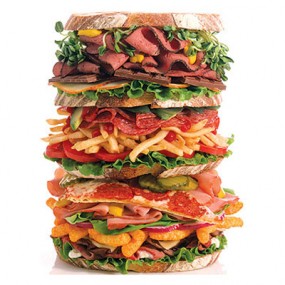- Fitness (19)
- News & Reviews (25)
- Nutrition (20)
- Science (10)
- Supplements (6)
- Technologies (8)
- The Arts (9)
Apples & Onions & Pesticides
June 14th, 2011
 By Scott Hensley for NPR: Maybe you overlooked the U.S. Department of Agriculture’s yearly roundup of pesticides in foods released last month. It’s long and full of tongue-twisting chemicals — like tetrahdrophthalimide and pyraclostrobin — found on some popular produce.
By Scott Hensley for NPR: Maybe you overlooked the U.S. Department of Agriculture’s yearly roundup of pesticides in foods released last month. It’s long and full of tongue-twisting chemicals — like tetrahdrophthalimide and pyraclostrobin — found on some popular produce.
But the Environmental Working Group, an advocate for stricter pesticide controls, has crunched the numbers from that report and a bunch of others to come up with a guide for concerned shoppers.
There’s a “Dirty Dozen,” headlined by apples, celery and strawberries. And there’s also a catchy “Clean 15” of fruits and vegetables lowest in pesticides. The top three on that list: onions, sweet corn and pineapples.
The EWG suggests that people buy organically grown fruits and vegetables for the varieties on its list of the most likely to carry pesticide residues. But the group also says the health benefits from produce mean that “eating conventionally-grown produce is far better than not eating fruits and vegetables at all.” Continue reading »
Harvard: Coffee Cuts Cancer Risk
May 29th, 2011
 This article gives us reason to drink coffee, but I don’t recommend the six cups mentioned in the study — that much can cause other problems!
This article gives us reason to drink coffee, but I don’t recommend the six cups mentioned in the study — that much can cause other problems!
By Roni Caryn Rabin for the New York Times: If that’s java in your cup, drink up. A new study says that men who are heavy coffee drinkers are at lower risk for prostate cancer.
As part of the Health Professionals Follow-Up Study, Harvard scientists followed 47,911 men who periodically described their coffee intake. The researchers found those who consumed six or more cups a day were almost 20 percent less likely to develop prostate cancer over two decades than those who drank none.
More important, the heavy coffee drinkers were 60 percent less likely than the non-drinkers to develop a lethal form of the disease. Even men who drank just one to three cups of coffee benefited: They were nearly 30 percent less likely to develop lethal prostate cancer, the study said.
It did not matter whether the coffee was caffeinated or decaffeinated. (Remember that decaf is more acidic than regular, so regular makes sense for those with reflux or heartburn, or those trying to maintain an alkaline diet. With palpitations or a heart condition, decaf may be better.– Cathie) Continue reading »
Filed under Nutrition | Comments Off on Harvard: Coffee Cuts Cancer RiskMeditation For ADHD Teens & Adults
May 1st, 2011
 Mindfulness meditation significantly helped three-quarters of the participants in a study described here by Dr. David Rabiner: Because of the wide spread interest in new ADHD interventions — particularly non-pharmaceutical approaches — I try to cover credible research in this area when ever I come across it. I was thus pleased to learn about a very interesting study of mindfulness meditation as a treatment for adults and adolescents with ADHD that was published in the Journal of Attention Disorders.
Mindfulness meditation significantly helped three-quarters of the participants in a study described here by Dr. David Rabiner: Because of the wide spread interest in new ADHD interventions — particularly non-pharmaceutical approaches — I try to cover credible research in this area when ever I come across it. I was thus pleased to learn about a very interesting study of mindfulness meditation as a treatment for adults and adolescents with ADHD that was published in the Journal of Attention Disorders.
Although medication treatment is effective for many individuals with ADHD, including adolescents and adults, there remains an understandable need to explore and develop interventions that can complement or even substitute for medication. (…)
In recent years, mindfulness meditation has been used as a new approach for stress reduction and incorporated into the treatment for a variety of psychiatric disorders, including depression, anxiety, and substance abuse. Of special relevance to the treatment of ADHD are findings that meditation has the potential to regulate brain functioning and attention. For example, research has demonstrated that mindfulness meditation can modify attentional networks, modulate EEG patterns, alter dopamine levels, and change neural activity.
Filed under News & Reviews | Comments Off on Meditation For ADHD Teens & AdultsWestern Diets Are Making the World Sick
April 16th, 2011
 From NPR’s ‘Fresh Air’: When physician Kevin Patterson described his experiences working at the Canadian Combat Surgical Hospital in Afghanistan, he noticed that the Afghan soldiers, police and civilians he treated in Kandahar had radically different bodies from those of the Canadians he took care of back home.
From NPR’s ‘Fresh Air’: When physician Kevin Patterson described his experiences working at the Canadian Combat Surgical Hospital in Afghanistan, he noticed that the Afghan soldiers, police and civilians he treated in Kandahar had radically different bodies from those of the Canadians he took care of back home.
“Typical Afghan civilians and soldiers would have been 140 pounds or so as adults. And when we operated on them, what we were aware of was the absence of any fat underneath the skin,” Patterson says. “Of course, when we operated on Canadians or Americans or Europeans, what was normal was to have most of the organs encased in fat.”
In a conversation on Fresh Air, Patterson tells Terry Gross that the effects of urbanization are making people everywhere in the world both fatter and sicker.
“Type 2 diabetes historically didn’t exist, only 70 or 80 years ago,” says Patterson. “And what’s driven it is this rise in obesity, especially the accumulation of abdominal fat. That fat induces changes in our receptors that cells have for insulin. Basically, it makes them numb to the effect of insulin.”
He explains that the increase in abdominal fat has driven the epidemic of diabetes over the last 40 years in the developed world — and that he’s now seeing similar patterns in undeveloped regions that have adopted Western eating patterns.
Patterson explains that in his Canadian practice, where he takes care of indigenous populations near the Arctic Circle, there is a marked increase in the number of diabetic patients he sees. “The traditional Inuit culture of relentless motion and a traditional diet consisting mainly of caribou, Arctic char, whale and seal has been abandoned over this period of time for Kentucky Fried Chicken and processed food and living a life very similar to ours,” he says.
Part of the problem, says Patterson, is that it’s so much cheaper for processed food to be flown into the Arctic Circle than fresh food. “There’s no roads or rail access to any of those communities,” he says. “So a 4 liter jug of milk can cost you $10 or $11. But there’s a very clear parallel between that and the inner city. In poorer neighborhoods in North American cities, fresh food is either not available or extremely expensive compared to — on a calorie-by-calorie basis — compared to fast food available on every street corner.” Continue reading »




